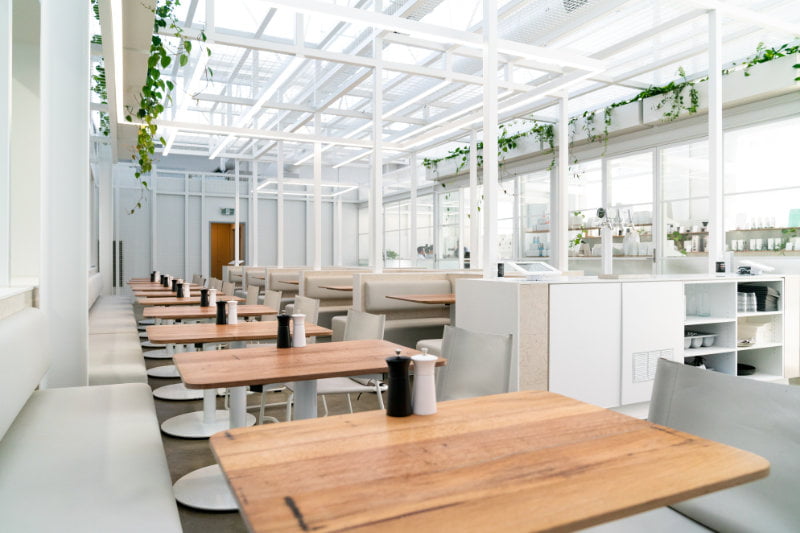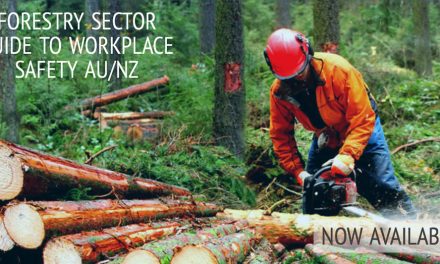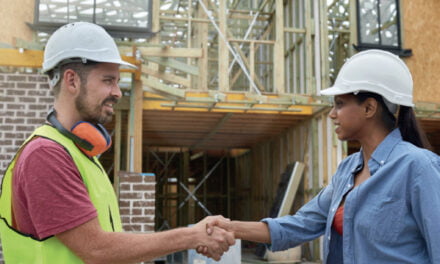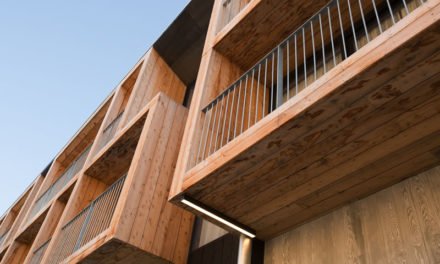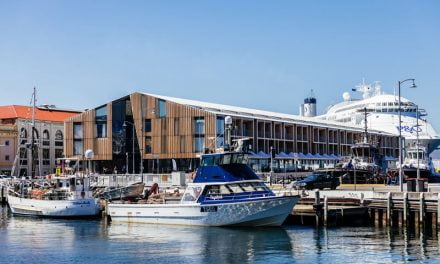Image: Reused doesn’t mean rustic, as in the slick interiors of the rebuilt by Revival Industry Beans cafe, Fitzroy. Photo by Tom Graham, courtesy of Revival.
Revival, a Melbourne-based sustainable building practice, has been shortlisted for a 2022 Premier’s Sustainability Award, thanks to their zero waste, zero footprint goals.
Robbie Neville’s business has just been named a finalist for a highly prestigious award, but he wants to talk about timber and brick. “They get me super excited because they’re one degree of separation from being raw material again,” he says. “Melbourne was built on them and, once we deconstruct a roof or a brick wall, it just needs to be cleaned and it’s a raw material again.”
As a man who has spent 22 years building structures, plus many of those also ‘un-building’ them for rebuild or reuse, Neville is an authority on what he calls “zero footprint repurposing”. His company, Revival, is a sustainable building practice with a full-service approach from registered builders to licensed structural engineers, joinery and furniture manufacture. They offer an existing materials consultancy service, coming in at the start of developments to show the commercial feasibility of deconstruction rather than demolition, and their own workshop uses exclusively recycled materials.
While their own practice is rigorous about reuse, the Revival team’s goal with clients is simply to take them as far down that road as they’re comfortable, making the case on cost, quality, carbon and sustainability benefits. “On larger scale commercial projects, we do a commercial feasibility on understanding what’s there and what’s its commercial value,” Neville says. “What will be the cost associated with deconstructing it rather than destroying it? What’s physically going to be involved in handling and transportation, in storage and machining it so that it’s ready and presents as a raw material again? And then the client can make decisions about how that case stacks up against other building methods.”
Whether the client commits 100% to reuse, or just 10%, the result is more material saved from landfill. But just as important is the fact the client has made a series of decisions about waste and the carbon cost of their project. “We’re not here to judge or critique anyone,” says Neville. “By having these conversations, we’re getting the ideas out there and increasing the scope and the circle of potential friends, partners, collaborators and allies.”
Now, this combination of high-quality production and accessible advocacy has been recognised with Revival named a finalist in Victoria’s 2022 Premier’s Sustainability Award, which recognises best-practice sustainability in Victoria.
Finding time to enter was the first hurdle. “With such a small team, I couldn’t delegate it,” Neville says. “But the award is really credible and gave us the opportunity to increase exposure and awareness around what we’re doing and what we’re trying to change in the industry. We saw a great opportunity to increase our momentum.”
In news that will be familiar to many of us, Neville submitted the entry in the last couple of hours of the deadline. “We were lucky,” he says. “The Awards interface was set up well and we have a lot of good content, whether it’s images, initiatives we’ve facilitated, or projects we’ve delivered. So it was just a matter of compiling all that in the required format and telling the story about what we’re doing.”
Hearing Revival named a finalist was a boost, particularly as the other finalists and past winners in the category tend to be big community spaces and councils. “Here we are, on a mission to change the way the building industry approaches existing materials,” Neville says. “So it was really validating and inspiring. You know what it’s like sometimes when you’re worn out from running the race. This was like someone giving you a cup of water and telling you you’re on the right track.”

Image: Robbie with Revival’s commercial director Stephy Neville and timbers waiting on refinishing. Photo by Amelia Stanwix, courtesy Revival.
ROAD TO REUSE
A third-generation builder, Neville describes his family as “really resourceful”. So when he started his career as a registered builder in Melbourne, he was keen to channel existing materials into his own projects. “I found that there were no systems or infrastructure that supported reuse,” he says. “And in our traditions and practices as an industry, people aren’t familiar or necessarily comfortable with the idea of embracing existing materials. I felt there were a few key reasons. One was structural engineering: the engineers I was working with were really gun shy about certifying existing materials, because they haven’t come off the shelf with nicely calculated documentation. And then when it came to joinery and furniture, people don’t like using old materials with their machines because they might hit a nail or blunt a blade.
“Critically, on bigger sites, people were overwhelmed by the idea of planning for the logistical aspects of incorporating reuse, especially on scale. It’s easy when it’s a token: ‘We built a skyscraper and here’s a dining table out of the previous building’s timber!’ But when you’re trying to make it more foundational, people shy away from it.”
Having identified the fundamental areas that were making reuse difficult, Neville set up his own company to tackle them. “My business partner at Revival is a structural engineer,” he says. “I’m a commercial and domestic builder. We have a workshop where we exclusively use recycled materials, nothing new comes in the door. And so we went to the industry and said, ‘if you’ve got a vision, using existing materials, we can bring it to life in-house. It’s going to be cheaper, there’ll be fewer businesses involved, and it’s going to be easy and fun.’”
RE-IMAGINING BUILDING
That was six years ago. Three years ago, Revival started targeting developers and designers. “It’s a strategy where we feel we’re going to make the biggest impact in terms of changing perceptions around existing materials, how relevant they are to new design and the inherent value of them,” says Neville. “On a development site, if there are existing buildings scheduled for demolition, we work with those partners to help incorporate the materials straight back into that new design.
“We call it ‘zero footprint repurposing’. That’s the crux of our submission for the awards. It’s really simple: it’s just breaking down those perceived barriers to entry, whether structural engineering or seeing the relevance of existing materials. Often people think that existing materials means rustic, so we try to showcase how refined they can be.

Image: Hip v Hype’s Ferrars & York development. Courtesy Revival.
“And when we can’t bring the footprint down to zero, we can get close. We worked on a Hip v Hype development where we had a pop-up workshop beside the structure we were demolishing (see photo above). We refinished materials as they came down and used them in our fit out at Casa de Vinos, 500m away, which itself is designed to be disassembled at end of life.” (See photo below.)

Image caption: Casa de Vinos in South Melbourne was built using the materials from the Hip v Hype site, 500m away. Courtesy Revival.
Revival partners with the client as early in the process as possible and assesses what’s already available on site, including options for repurposing; costs for time, transport and readying those materials for reuse; plus documenting them as a kit of parts in the language of architects and designers.
“They work through our kit of parts similarly to working through a catalogue of new materials,” Neville says. “It provides all the detail at a really granular level, so there’s no surprises. We capture all characteristics of those existing materials in that document so the design can be confident.”
As part of the process, Revival calculates sequestered carbon and reports on the savings from reuse as compared to the cost of manufacturing and transporting new materials. While carbon accounting isn’t yet mandated, Neville says clients are increasingly focused on this information in their decision making. In later stages, Revival also takes responsibility for prototyping and shop drawings and works with other stakeholders or contractors to bring the project to life.
“We’re the only existing materials consultants of this kind in Australia, if not the world,” Neville says, “and we’re unique in the way we can straddle a project from pre-concept design right through to occupied use. We take accountability for what we do in that entire process.”
Revival is one of only two builders in the country with B Corp accreditation (which measures a company’s entire social and environmental impact) and has seen the positive impact of the reports it prepares for clients when they are included in the planning permission application.
Ironically, planning is a key area where Neville and his team would like to see legislative change around the responsible handling of existing materials. “We need policies and controls in the planning permission schemes our local councils have in place, so that as part of that application, there’s a legal framework you need to follow when it comes to handling existing materials.
“It’s mind-blowing to me that doesn’t yet exist. There’s a complete absence of accountability. The builder’s not responsible for how much they send to landfill, nor is the developer and the councils don’t have any controls. Councils can control what colour paint you use, but not whether you knock the whole thing down and put it into landfill.”
In the projects Revival has worked on, the team has introduced mechanisms and processes that show such policies are feasible and possible. They hope to be able to hand these over as tested systems once legislative bodies decide to regulate this area.
The company has its biggest impact when working in a multi-dimensional capacity on a building project: as a structural engineer and existing materials consultant, then principal contractor/builder, as well as manufacturing the joinery and the furniture. Materials come off-site for a clean-up or repurpose in the workshop then go straight back onto the same site. On large-scale developments, Revival might facilitate the salvage, then manufacture a joinery package or be the principal contractor for the fit out element.
“On the jobs where we do the whole package, being a single business keeps the cost down,” Neville says. “And we’re not at the mercy of perceived barriers to entry that other builders or joiners might have, when it comes to using existing materials.”
At the same time, if the client wants, say, re-used timber framing but new joinery, Revival will subcontract the job. Or for the reverse, the team will buy in MGP10 for the walls and concentrate on the joinery and furniture package in their workshop.
“We’re black and white about what we do in our own workshop, but we have a better chance of making change by working within the comfort zones of our clients,” says Neville.
The current big project is in Collingwood, on Easey Street. “It’s the poster child for adaptive reuse,” Neville says. “It’s a 1000m2 footprint and two storeys. We’re making significant structural modifications: a new concrete deck on the first floor and structural steel throughout that we’ve had to introduce to meet seismic standards. We’re ripping off the roof and putting in solar and a Tesla lift.
“It’s a massive commercial project but throughout the demolition we’ve salvaged every last scrap of timber and brick. And they’re all going straight back into the building. We had to replace the structural columns, which turned out to be 200x200mm Jarrah. There’s 25 of them and we’ll be machining those for various features throughout the design. If we were to exclusively operate using only existing materials and not be involved in projects like this that would be impossible to do that way, that would really bring limitations to where we can make an impact.”
Revival looks to make impacts elsewhere, too, running workshops for women and providing a safe work experience program on the company’s sites. “Gender inequality in construction is worse than any other industry,” says Neville. “I believe that’s the heart of a lot of the issues we have with our industry culture. With more of a balance, we might have a healthier industry for everyone.” Similar programs for teens are coming soon.
For Neville, it’s all about planning for a better future. “Working with people like Sustainability Victoria, Development Victoria and local councils means the discussion about reuse is predicated on tangible, delivered results. It’s not a theory,” he says. “At some point soon, the whole industry will recognise that we need to be minimising our waste and maximising our reuse Things like this award are only going to help in getting ready for that.”
See more at www.revivalprojects.com.au Winners to be announced 20 September, 2022, see www.sustainability.vic.gov.au

